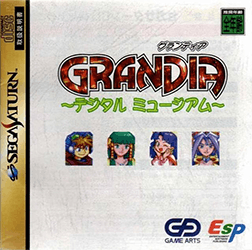Grandia: Digital Museum
| Grandia: Digital Museum | |
|---|---|
 | |
| Developer(s) | Game Arts |
| Publisher(s) | ESP Software |
| Composer(s) | Noriyuki Iwadare |
| Series | Grandia |
| Platform(s) | Sega Saturn |
| Release date(s) | |
| Genre(s) | RPG |
| Mode(s) | Single-player |
| Distribution | 1 × CD-ROM |
Grandia: Digital Museum (グランディア ~デジタルミュージアム~ Gurandia Dejitaru Myuziamu) is a role-playing video game developed by Game Arts and published by ESP Software for the Sega Saturn. Released exclusively in Japan in May 1998, the game is a spin-off of the company's first Grandia title, and is designed to be more of an extension of the original than an independent game, featuring character graphics, textures, and music lifted directly from its predecessor. Players can also swap save data between the two games on the Saturn memory card.
The game's story is set sometime after the events of the original Grandia, with the main characters Justin, Feena, and Sue being transported to a large museum created by the sorceress Liete made to honor their adventure during the first game. When most of the exhibits go missing, Liete uses her magic to transport the three to four separate dungeons each containing remnants of their previous journey to find and restore them to their proper place. As players progress through the game, bonus material becomes unlocked in the museum itself, which includes music files, artwork, and movie clips related to Grandia, as well as minigames.
Gameplay
The Museum Itself
The following exhibits are found in the four dungeons:
* Artwork and storyboards - Several pieces of rare artwork and storyboards. Each one carries a small collection which can be viewed.
* Character Portraits - The character portraits that pop up each time a character is speaking.
* Sound Theatre - A collection of sound or radio plays featuring the Grandia cast.
* Grandia 1 saves - Allows the player to download a save file for use in the full Grandia 1 game.
* Bestiary - A library of all the monsters and their characteristics.
* Arcade - An arcade with mini-games. Including games such as baseball, archery, an eating competition, and a text-based game.
Reception
Grandia: Digital Museum debuted as the fifth highest-selling game of the week during its launch in Japan, and would go on to sell approximately 32,226 copies in its first month.[2]
References
- ↑ グランディア ~デジタルミュージアム~ (in Japanese). Game Arts. 1998. Retrieved 2009-11-08.
- ↑ "Top 30 Weekly Sales Report". Weekly Famitsu (in Japanese) (Enterbrain, Inc.) (498). 1998-06-07.
External links
| ||||||||||||||